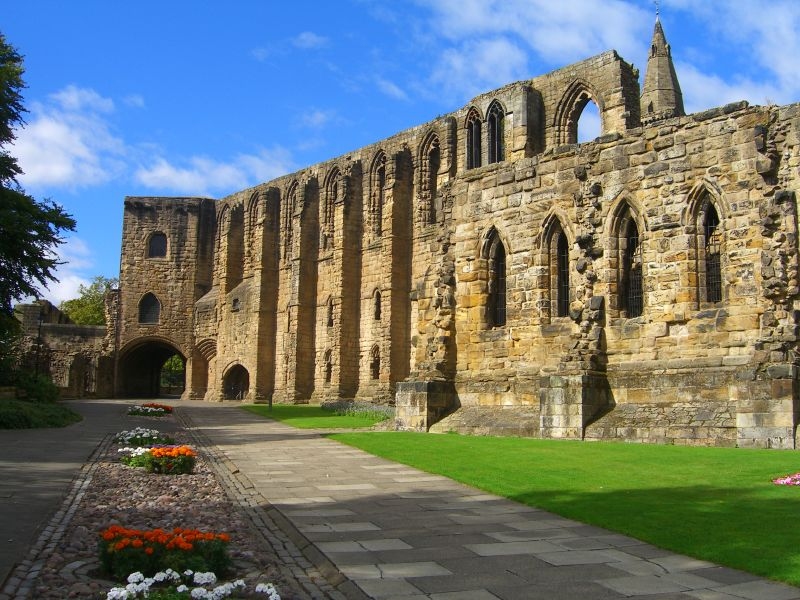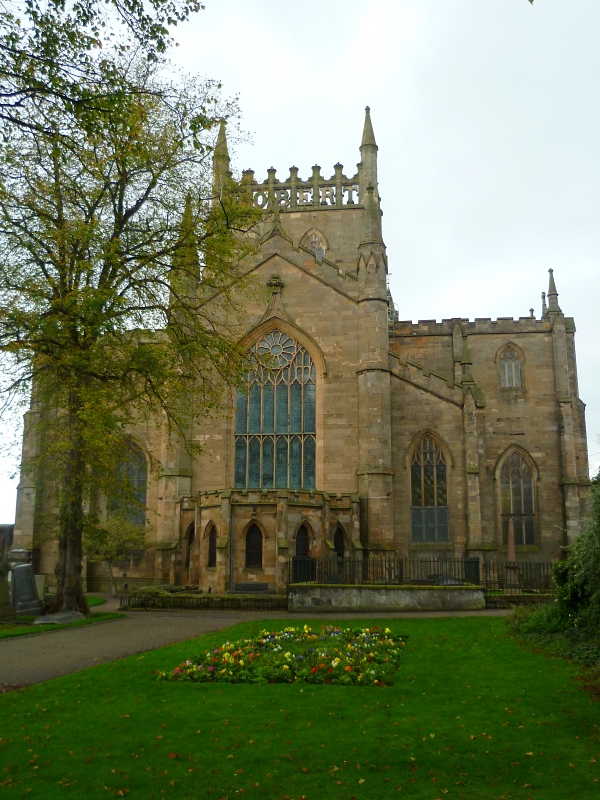
Dunfermline is a much larger and more modern town than I had imagined. The traffic is horrendous and the signs to the abbey are alternately nonexistent and misleading. Once in the midst of town we can easily see the spires of the church and the carved letters that spell out King Robert The Bruce on the parapet, but there seems to be no way to get to it.
Here we come across what I mentally dub a "monster roundabout" – a roundabout that leads to another roundabout with a typical American-type stoplight-equipped intersection between the two. On a Saturday afternoon in summer, it is best avoided by any means, yet we work our way through it before finally deciding to abandon the car in a multilevel car park and seek out the abbey on foot.
When Queen Margaret, later St. Margaret, married Malcolm II "Canmore" around 1070, Dunfermline was already a place of royal residence. Margaret founded a Benedictine priory at Dunfermline, and her third son, David I, raised it to Abbey status in 1128. The abbey was the chosen burial place of eight kings, four queens, five princes and two princesses. In addition, William Wallace's mother, Margaret, is buried here. In the 16th century the abbey guest house was converted into a royal palace. The last monarch to be born in Scotland, Charles I, was born there.
After two symbolic strikes with Fowlis Wester and Loch Leven, Dunfermline is definitely a home run. As we enter the grounds I head directly for the ruins of the guest house/palace, while Dana and Robin go into the 19th century parish kirk. I hesitate for a moment, wondering if I should walk back to join up with them, but as usual, the ruins are a much stronger draw for me, so I venture on.
The woman in the admission center takes a cursory glance at my pass; I've interrupted her snack of cheese savory and tea, but she's very kind and smilingly points out that I have the ruins to myself this afternoon.
I wander through the kitchen, chambers and vaulted-ceilinged bays in silence, closing my eyes every few moments to absorb the atmosphere. Up winding narrow stairs I look out arched windows over the town. Other than a huge fireplace, there's nothing spectacular about the ruins, but I enjoy my time alone here, thinking of the people in whose footsteps I am walking.
Back down the stairs for a final look at the crumbling remains of walls which I imagine would have been separate bedchambers and suddenly the air is filled with the sound of bagpipes. I stand stock still with my eyes closed, as the pipes reverberate through the ruins, plucking at my heart strings.
I've no concept of how long I've wandered here alone and head back to find Robin and Dana. As I leave the guest house I quickly step back to avoid being caught in a photograph. Three kilted men are posing, using the ruins as a backdrop. I peek around the corner to see a woman in a wedding gown surrounded by smiling family and friends and wonder if Dana and Robin crashed the wedding.

Dunfermline Abbey is a Church of Scotland Parish Church in Dunfermline, Fife, Scotland. The church occupies the site of the ancient chancel and transepts of a large medieval Benedictine abbey, which was sacked in 1560 during the Scottish Reformation and permitted to fall into disrepair.
Part of the old abbey church continued in use at that time and some parts of the abbey infrastructure still remain.
Dunfermline Abbey is one of Scotland's most important cultural sites.
Read more about Dunfermline Abbey at Wikipedia.